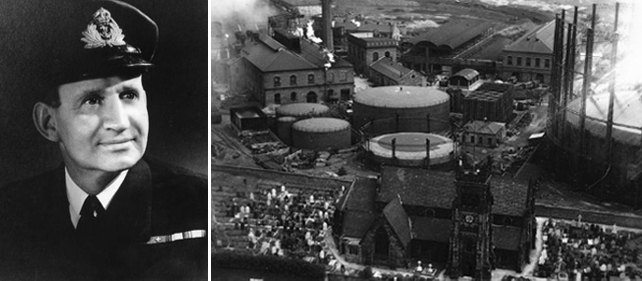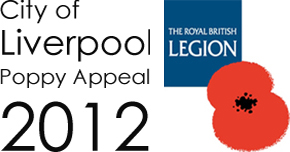In the very early hours of November 29th 1940 a parachute mine landed on the Garston Gas Works. It was not known whether the mine or bomb in the 4,000,000 cubic feet holder tank was magnetic, acoustic, delayed action or just a plain “dud”. Therefore fearing it might detonate at any time, the authorities evacuated 6000 people living in the vicinity to escape what would have been an almost unimaginable explosion.
At 7.30am fitters, electricians, plumbers and others were at work disconnecting electrically driven blowers from other plants, rigging them into position on the holder tank and preparing the fire pump to draw water out. These high-risk tasks were carried out by willing volunteers. As the exact location of the mine was unknown, risks had to be taken. First the fans were started up and nothing happened, then the motor pump, and still no explosion. The men who had assembled the gear were withdrawn. The Liverpool Fire Brigade arrived and put a pump to work, the water was taken down 5’ 6” to uncover part of the “dumping”, a brick faced island inside the holder. This achieved, the air inside the holder tank was no longer considered explosive and means of access were considered.
Fans and pumps were stopped and the job was handed over to Lieutenant Newgass of the bomb disposal unit. Then aged 41, Newgass was a veteran of the Great War and hailed from London.

Donning oxygen apparatus which only lasted thirty minutes apiece, Lieutenant Newgass entered the holder tank. He lashed the parachute ring of the mine to the top of the pillar against which it was leaning, and passed a lashing round the nose. Unfortunately the fuse was facing the pillar so a special hoisting lug was affixed and the mine was carefully turned round with a “tommy bar”. This was a great physical effort for one man working under immense pressure and wearing oxygen apparatus for the first time.
For two days Newgass battled to defuse the mine. On 30th November the fuse, the magnetic primer and the clocks were all removed. Newgass was then able to report that although the detonator was still in, the mine could be considered safe.
Garston employers then entered the holder and uncoupled the lashing. The mine, which in size and appearance resembled a tug boat funnel, was pulled over on its side, dragged across the “dumping” to a position under the hole on the crown and lifted out by block and tackle. It was then placed on the back of a lorry and driven away.
It is certain that had the mine be detonated, the whole of Garston Works, along with much neighbouring property, would have been completely destroyed in the blast. Lieutenant Newgass was awarded the George Cross, the highest civil decoration available. Local newsagent and tobacconist, Miss Connie Elliot of St. Mary’s Road, started a public collection for the mine disposal squad, resulting in generous gifts being presented on behalf of the grateful people of Garston.
The way in which the ordinary man responded to this dangerous incident by selflessly placing themselves at grave risk in order to keep many more thousands of people safe, was hailed as a great example of the blitz spirit.













 About
About